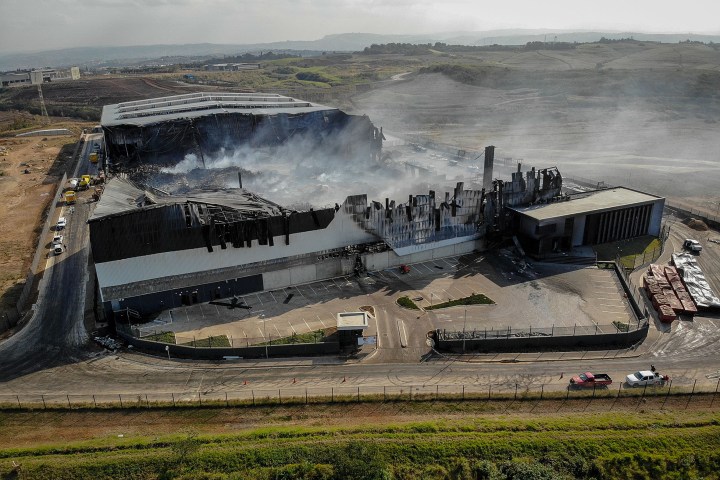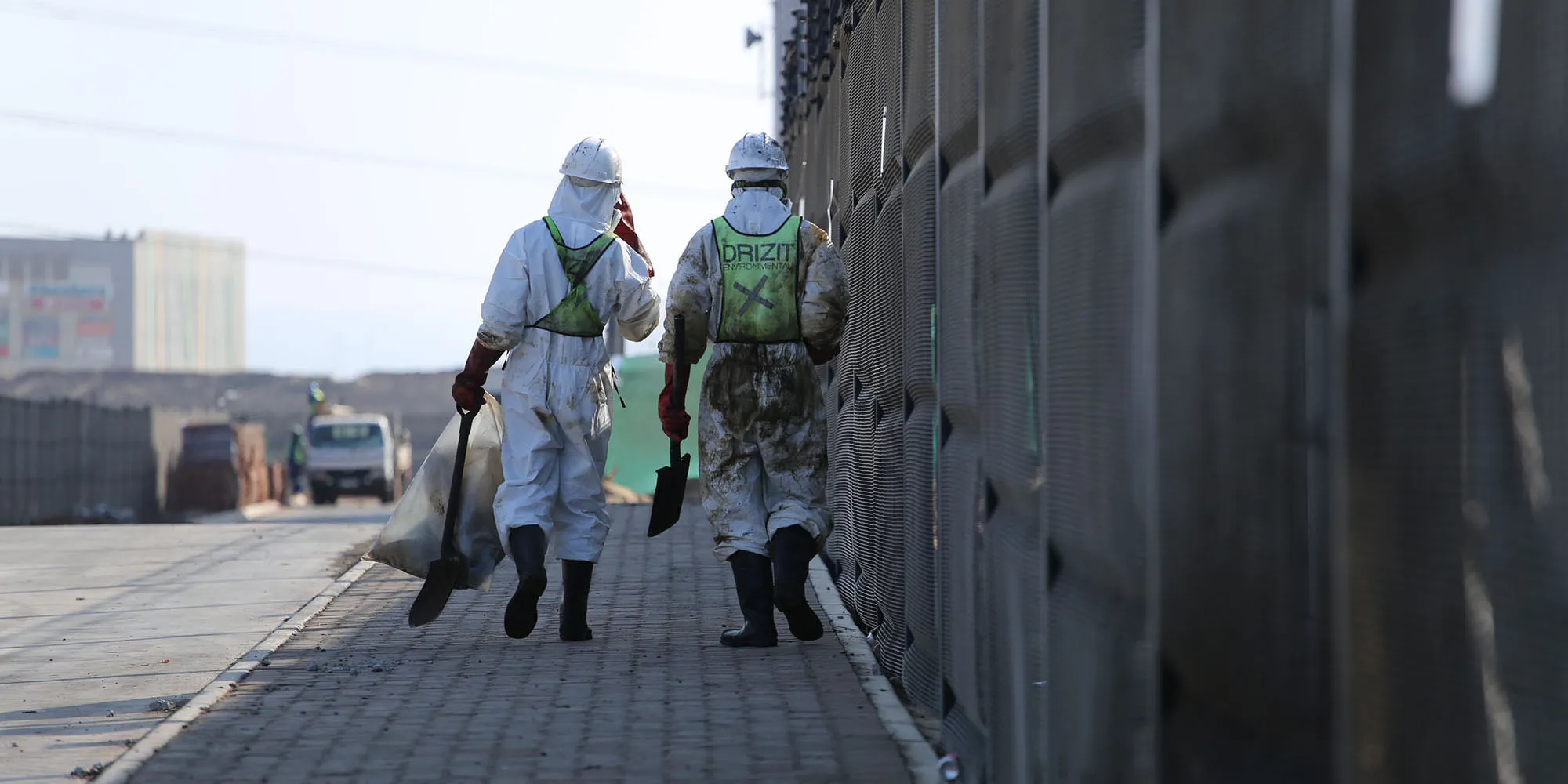AMABHUNGANE
UPL fire: here’s the full inventory of chemicals in the destroyed Cornubia warehouse

The long list of deadly pesticides, herbicides and intermediate products in the burnt-down warehouse contains hundreds of entries totalling over 6,000 cubic metres. Among the chemicals are several banned in the EU and other countries, ranging from China to Sri Lanka.
The chemical giant UPL has been tight-lipped about the contents of the warehouse torched during July’s unrest, emitting a choking blanket of smoke over surrounding communities and poisoning an adjacent river and wetland.

Four months ago, agrochemical giant UPL quietly moved into a newly built warehouse in Cornubia, Durban. (Photo: Mlungisi Mbele)
On Tuesday, amaBhungane revealed much of the extremely toxic contents, piercing the persistent secrecy. Today we are making the full inventory of the warehouse available to readers.
See amaBhungane’s article in Daily Maverick: Here it is: the toxic stockpile of chemicals in torched United Phosphorus Limited Durban warehouse
A perusal of the inventory shows that UPL was storing large quantities of chemicals that are banned elsewhere in the world but not in South Africa.
Among these products banned in the EU and elsewhere are:
- More than 40,000 litres of paraquat-based herbicides which have been banned in more than 50 countries including the UK, China, Switzerland and Thailand;
- Roughly 150,000 litres of atrazine-based products and another 30 tonnes in dry form. Atrazine is banned in 31 countries including the EU;
- 36,000 litres of chlorpyrifos-based products which are banned in the US and EU;
- Almost 92 tonnes of mancozeb-based products which are banned in the EU;
- 141,000 litres of 2,4-D-based products and 51 tonnes in dry form, banned in Vietnam, Norway and Mozambique;
- More than 37 tonnes of products using maleic hydrazide which is banned in the EU except under exceptional circumstances and also banned in India; and
- More than 26 tonnes of methomyl-based product banned in India and used under severe restrictions in the US.

Clean-up crews have been working on the site from day one, while residents wait for test results from UK laboratories. (Photo: Mlungisi Mbele)
UPL publishes all the safety data sheets (also called Material Safety Data Sheets) for their products on its website. One can search according to the product name or the active ingredient. The safety data sheets provide information about the hazards associated with the products, and both the short- and long-term health and environmental impacts of the products. DM




















 Become an Insider
Become an Insider
O my word WE NEED A NEW GOVERNMENT
It is of utmost importance that this story is followed up by all the amazing journalists who have covered this story so far. We thank you for your effort. Please don’t let up on this.
The list is out there, it would be good to know what these chemicals are used for. Why do we need them in South Africa and who is using them.
The government environmental departments need to answer for the use and why we are slow in banning these chemicals. The Department of Agriculture needs to answer for this if they are allowing the use of these toxic chemicals.
The food supply chain should be questioning the use of these chemicals if they are being used in agriculture.
The insurance company should be questioning if any of these chemicals are banned in SA and have been imported illegally, therefore negating the claim.
The citizens of South Africa are sickened by the behaviour of people who operate with impunity. It just never seems to stop.
The Municipal planning department needs to answer for not insisting on the regulatory moat which warehouses of this kind are supposed to have in place.
Who signed off on the plans of the DC. Who signed off on the imports of these toxic chemicals, assuming they need licenses.
I agree completely. We now know what is in the warehouse …but what has been there, and where has it gone. Way bigger scandal potential on this.
“The citizens of South Africa are sickened by the behaviour of people who operate with impunity.” – No they’re not. They keep on voting for the anc. For the rest – I agree with you.
Sorry kiddo we have to make do with this one…there is no one better in the wings! At least the Minister of the Environment is onto this! Now we have to hope that the due diligence on the Turkish “ powerships” proposal is properly adhered to, as well as a real and comprehensive EIA to ensure that no more eco destruction happens on the SA coastline. Backhanders to the “ANC connected” from India, Turkey, China and Russia has to stop! Political Vigilance and media groups like DM are going some way in monitoring accountability. We have to play our part as well.
If the Minister of Environment were onto this, how was the plant built in the first place, not to speak about what was inside and how and why it got there? No-one better in the wings, huh?
I think the factory was built in the days of apartheid. I may be wrong, though.
It was a warehouse, not a factory, and really very new!
The Ethekwini Metro was responsible for approving the Cornubia mixed development area and must have approved each and every application for whatever construction was completed including this enormous warehouse. They have much to be responsible for in this disaster and must be cfalled to account as well.
Apart from the environmental atrocity that has been unleashed by this fire on the local and not so local environment, the further very disturbing issue is that these toxic chemicals were bound to be unleashed onto soils and into the air across South Africa. It is time to push to expose and challenge the fact that our farming sector continues to deposit tons of these kinds of chemicals into our environment. This is also an environmental atrocity just not as visible as the fire of the last weeks.
Stored here but banned in the rest of the world means this is a toxic dump site. Minister this is really big. We need international outcry to help us put pressure on why we got to where we are. So researching toxic dumping I came across “environmental racism. This is a term that’s used to describe a form of systemic racism – manifested through policies or practices – whereby communities of colour are disproportionately burdened with health hazards through policies and practices that force them to live in proximity to sources of toxic waste.” Sound like what we have here. Obviously palms were greased to get where we are.
As the engineer involved in building, and later manager, running South Africa’s first herbicide manufacturing facility 30+ years ago outside East London, we had to comply with every safety/health standard imaginable. And rightly so. I am appalled that the authorities allowed this warehouse to be located next to a Makro, down the road from further retail activities, and close to a residential area. And to warehouse hazardous liquids, bund walls to contain spillage, are a prerequisite. Authorities again!! Yes, rightly blame UPL – they knew the rules were being bent and broken, but as much blame must be levelled at the relevant authorities for closing their eyes and allowing this situation to happen. Whether money changed hands to look the other way is another matter entirely!!
30+ years ago the anc was not ruling SA. It is as simple as that.
Hopefully a class action suit will be instituted against this delinquent company !
Firstly, i am pleased i don’t live in that area. I believe sooner that sooner rather than later this should be seen as a Class Action suit jointly against the company and the municipality. This will be with us for decades.
As a short-term immediate and urgent reaction the entire community next to the facility must be moved to a safe environment. Not ASAP. Now.
A positive of the rioting. Exposing this abuse. Time for SA law makers to get with the program.
While it is understandable that their is a lot of fear and resentment regarding agrochemicals, use of such compounds in responsible and regulated societies ensures that the hundreds of types of monocultures by which we humans feed ourselves, are secured. This atrocity is not in the fact that agrochemicals need to be used by farmers, but in the fact that the storage facility did not meet safety requirements.
All commercial farming units in South Africa today are audited out of their minds by various regulating bodies to ensure compliance with food safety regulations. We should keep our emotions in check when we have insufficient understanding of the full picture.
Also consider that many of the products destroyed were not in their final (application) format. It is highly likely that South Africa was not the end point for some of the chemicals that were stored at this facility. In which case, once again, we were probably the easy entry into other destinations due to political blind eyes…
While it is understandable that there is a lot of fear and resentment regarding agrochemicals, use of such compounds in responsible and regulated societies ensures that the hundreds of types of monocultures by which we humans feed ourselves, are secured. This atrocity is not in the fact that agrochemicals need to be used by farmers, but in the fact that the storage facility did not meet safety requirements.
All commercial farming units in South Africa today are audited out of their minds by various regulating bodies to ensure compliance with food safety regulations. We should keep our emotions in check when we have insufficient understanding of the full picture.
Also consider that many of the products destroyed were not in their final (application) format. It is highly likely that South Africa was not the end point for some of the chemicals that were stored at this facility. In which case, once again, we were probably the easy entry into other destinations due to politically blind eyes…
Question: How did UPL get the EIA passed for this facility when there was no retention berm around the facility ? One can see this clearly from the drone photo of this article, with a bird’s eye view of the site. The idea of a bund or a berm (either a moat or high walls around the perimeter of the site) is that, if and when there is a fire or a spill of toxic compounds, then the toxic compounds shall be retained within the facility, together with any water sprayed onto the fire to extinguish the fire. It is a basic EIA requirement globally for all sites storing toxic compounds. So how did they get permission to move into this site without meeting this basic requirement ?
Management and the relevant authorities are the only people that can answer your questions. It is suffice to say that every rule in the book was broken/waived. Their insurers must be waiving their policy requirements at someone.
Thank you Daily Maverick team for your excellent reporting. Is there a Facebook or other social media group to allow people affected by this disaster to rally together and even support one another? I’ve asked a friend with ties to various activist groups and it appears not.
Individuals and civil society need to collect and record as much data as possible for future litigation against UPL and the SA government. I think that a FB group will be invaluable to do this.